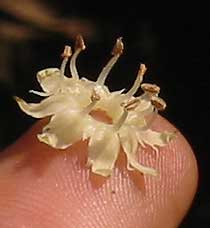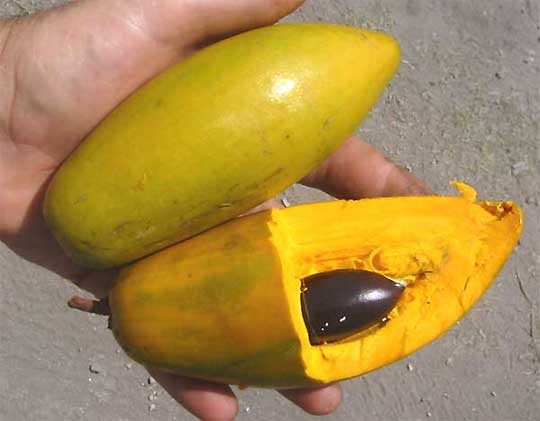Excerpts from Jim Conrad's
Naturalist Newsletter
from the May 12, 2008 Newsletter written in the community of 28 de Junio, in the Central Valley 8 kms west of Pujiltic, elev. ~700m (2300ft), ~N16.331°, ~W92.472°; southeastern Chiapas state, MÉXICO
THE SAPOTES
 Up at the cascades, beneath a certain large tree with dark green, magnolia-like leaves, the ground is tinged yellow with the fallen, neat little items shown at the right.
Up at the cascades, beneath a certain large tree with dark green, magnolia-like leaves, the ground is tinged yellow with the fallen, neat little items shown at the right.
In that picture the erect, matchstick things are stamens, each stamen consisting of a sticklike, pale filament and a brownish, baglike anther, which splits open to release pollen. Notice that -- unusual among flowers -- this flower's stamens arise opposite its petals; usually stamens alternate with petals. Also, notice the tiny, triangular things the same color and texture as the corolla between the corolla lobes. These are staminodia, or sterile, modified stamens. Finally, notice that the petals or corolla lobes sometimes bear tiny teeth along their margins. They're "lacinate," or cut.
Any flower displaying these distinctive features just can't be from anything other than a member of the Sapodilla Family, the Sapotaceae. In North America the best-known members of the Sapodilla Family are the US Southeast's bumelias. Breedlove's Flora of Chiapas lists 27 species names for the family here and most of them are trees producing edible, often transcendently delicious fruits.
In fact, some of tropical America's most cherished native fruits are produced on trees in this family. The most famous are the Chicozapote or Sapodilla produced by the Chicle Tree (natural chewing-gum base), Manilkara zapota, and the Mamey or Marmalade-Plum, Pouteria sapota. If you're ever in a good traditional market in tropical America, ask for Chicozapote and Mamey fruits.
Sometimes the names vary from region to region, and even the Latin names have been changed so frequently that often it's hard to figure out what's what. Moreover, you're always running into seldom seen but wonderful fruits of this family. For example, the other day Don Andrés came to my door with the fruits below:

Here this fruit is called Sapote Colorado but I think it's the same as what I know from Guatemala as Caimito Amarillo, Latin name Pouteria caimito. The fruit tastes like a slightly dry but sweet yam or sweet potato.
In the field, trees in the family bear alternate, simple, smooth-margined (entire), leathery leaves, often clustered toward branch tips. Typically they exude white latex (like Chicozapote's chewing-gum base) when injured. An immature Cicozapote with leaves is shown below:
